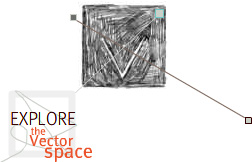Unmarked Planes and Hidden Geographies
Design by Craig Dietrich & Raegan Kelly
Author's Statement
You can learn a lot about geography by tracking the movements of airplanes. Open up the in-flight magazine on any airplane and you'll see what I mean. Within the glossy pages of those magazines, you'll inevitably find maps of the world with lines connecting cities to one another ”" these are of course routes flown by the airline whose plane you're sitting in. But they represent something more than that. Aircraft flights and routes help visualize a form of what geographers call "relational space": the often hidden ways in which non-contiguous spaces are in fact profoundly interwoven. London is intensely connected to New York to Los Angles to Tokyo”¦ one the other hand, how many lines connect to Kinshasa? Ashgabat? Kabul? These absences represent a different kind of relational space.
But there are many, many kinds of aircraft besides the cramped, coach-class commercial planes that many of us are accustomed to. There are the private executive jets of the extremely rich; the light prop planes of recreational pilots; the cargo fleets of UPS, Federal Express, DHL and the like; the helicopters and light planes of police departments; need I go on?; then there is, of course, the military. And within the military ”" which sometimes seems like a world unto itself - there are also scores of different aircraft types: cargo planes, fighters, bombers, trainers, transports, spy planes. Just as the movements of commercial aircraft describe various kinds of relational space, so do the movements of military aircraft.
This project is about one very peculiar subset of military aircraft ”" a fleet of nondescript Boeing 737s and Beechcraft King Airs that use the call-sign JANET when they're operating in civilian airspace. The JANETs are an airline operating in the service of the military whose purpose is to shuttle workers to and from a collection of secret military installations in the Southwest and to undertake support operations for some of the most obscure activities within the Military Industrial Complex. The JANETs' movements represent a very peculiar kind of relational space indeed ”" a geography of secret projects, places, and people that military and defense-industry insiders refer to as the "black world."
To develop this project, we've taken advantage of an unlikely contradiction in the way that this fleet of aircraft is set up. Because the JANET fleet operates under the guise of a civilian (rather than military) organization, the fleet has to obey the conventions of civilian aviation. These conventions include filing plans with the Federal Aviation Administration for each flight, and updating large files of maintenance records and registration histories with the FAA. For good reasons, these sorts of documents fall squarely in the public domain. Flight data from the JANETs, for example, is available in near-real time.
To build this project, we've taken advantage of these public data sources in order to build an application that maps ”" in close to real time ”" the production and reproduction of the "black world's" secret geographies.



